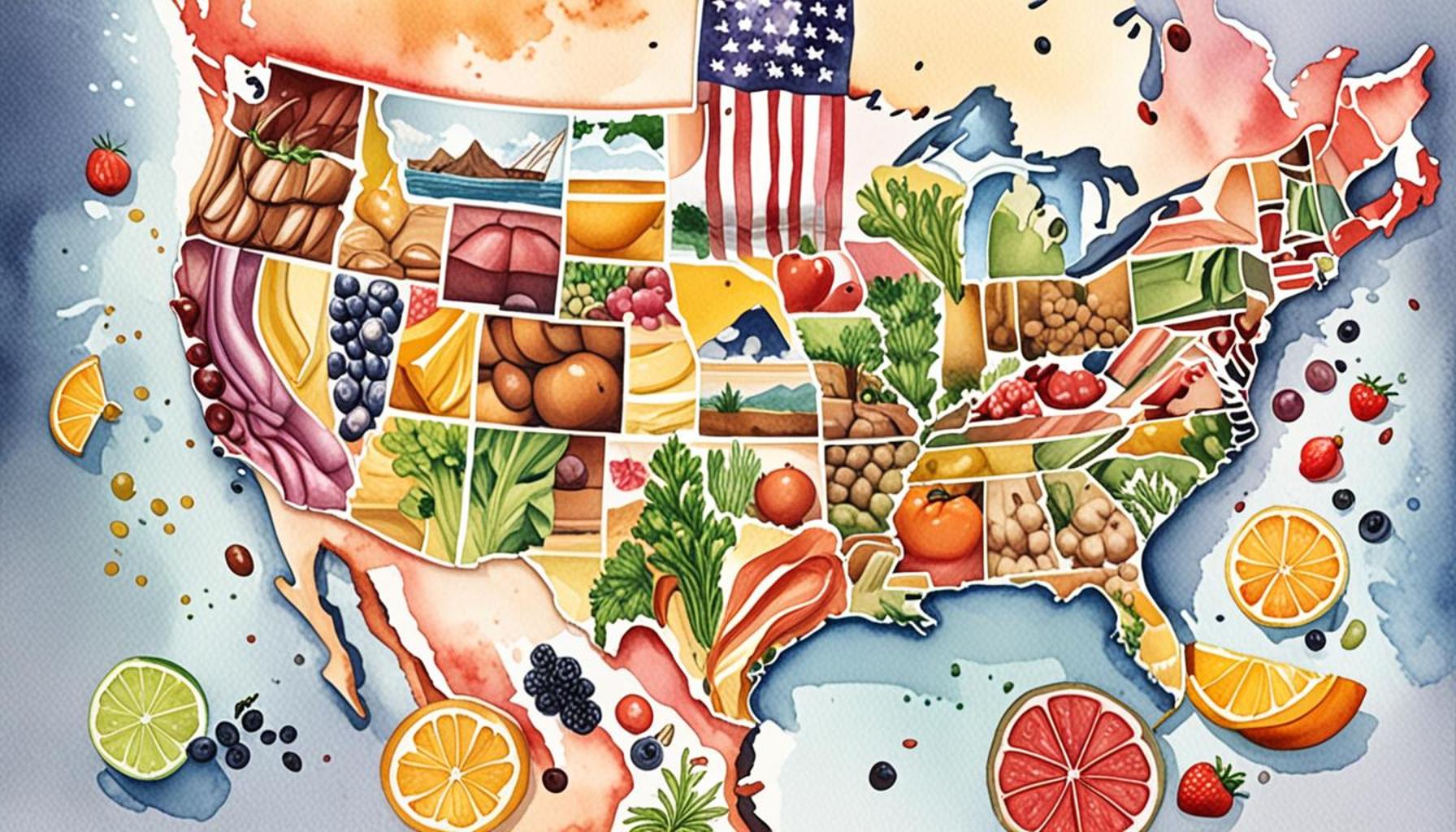The Influence of Immigration on Local Cuisine: Culinary Routes that Celebrate Diversity

The Culinary Tapestry of Immigration
Every bite tells a story, filled with rich narratives of cultural exchange, adaptation, and history. The influence of immigration on local cuisine reveals itself in numerous ways, transforming the culinary landscape across the United States. From bustling street vendors dishing out authentic tacos in Los Angeles to upscale restaurants in New York offering innovative fusion dishes, the vibrant flavors of the world have found a welcoming home in American kitchens.
This culinary diversity is worthy of celebration for several compelling reasons. One of the most striking aspects is the innovation that arises from cultural intersections. For example, the trendy Korean taco, a scrumptious blend of traditional Mexican and Korean flavors, exemplifies how culinary boundaries can be pushed to create unique dishes. This innovative spirit not only tantalizes taste buds but also encourages chefs to experiment with new ingredients and techniques that honor their heritage and create something entirely new.
Furthermore, the economic impact of immigrant-owned restaurants cannot be overstated. According to the American Immigration Council, immigrants are responsible for more than one-quarter of all small businesses in the United States, many of which are food-related. These establishments contribute significantly to local economies, creating jobs and revitalizing neighborhoods. Consider the vibrant communities that have emerged around areas like San Francisco’s Mission District, where the success of immigrant-owned eateries has led to increased foot traffic, attracting more businesses and investments.
In addition to economic benefits, these culinary experiences offer invaluable cultural education. Food serves as an accessible gateway to understanding various heritages. Visiting an Ethiopian restaurant, for instance, can introduce diners to traditional injera bread and communal eating practices, allowing them to engage with the culture in a meaningful way. This immersive experience transcends language barriers and fosters connection in communities that might otherwise remain divided.
From the classic Italian pasta dishes of New York to the aromatic Vietnamese pho of Los Angeles, each dish mirrors the migration patterns and histories of its creators. This powerful connection between food and identity invites us to experience flavors that reflect resilience, tradition, and the blending of communities. As we explore these culinary routes, we discover not just treasured recipes but the shared human experiences that bind us together.
The evolution of American cuisine in response to immigration not only enriches our palates but also encourages dialogue and understanding across different cultures. Join us in delving deeper into how immigration continues to reshape local cuisine, celebrating the dynamic tapestry of flavors that define the American culinary experience.
DISCOVER MORE: Click here for exciting itineraries
The Fusion of Flavors: Immigrant Contributions to American Cuisine
The rich and diverse tapestry of American cuisine is woven from the stories of countless immigrant communities, each adding their unique threads of flavor and tradition. The landscape of local cuisine is not just a byproduct of residing in a particular area; it is a living testament to the journeys of those who brought their culinary heritage to this land. As we dissect the layers of food culture, we see how specific groups have made an indelible mark on regional specialties, transforming meals into a celebration of diversity.
One of the most notable examples of immigrant influence is seen in the rise of regional cuisines across the United States. Cities like New Orleans boast an intricate blend of Creole and Cajun flavors, originating from French, Spanish, and African culinary traditions. The luscious gumbo and jambalaya found in this vibrant city illustrate how immigration has contributed to a truly distinct regional identity. Similarly, the Somali community in Minnesota has introduced dishes like suqaar and sambusa, reshaping the Midwestern culinary landscape and showcasing the resilience of its people through food.
Highlighting the Role of Regional Ingredients Understanding the significance of local ingredients in immigrant cooking reveals another layer of this culinary evolution. Many immigrant communities have adapted traditional recipes to utilize ingredients readily available in their new environment. This resourcefulness has led to innovative dishes that reflect the melding of old-country flavors with local produce. Here are some examples:
- Asian Influence in California: The integration of fresh, local seafood and vegetables into traditional Asian stir-fries and sushi showcases how immigrant chefs have embraced Californian produce to enhance authenticity.
- Mexican Heritage in Texas: Tex-Mex cuisine flourishes from the fusion of traditional Mexican flavors with Texan ingredients, creating beloved dishes like breakfast tacos that exemplify this cultural blend.
- Italian Roots in New York: The establishment of pizzerias by Italian immigrants in New York led to the creation of the iconic New York-style pizza, a perfect example of how regional preferences shape culinary discourse.
This ongoing dialogue between immigrant cooks and local produce illustrates the adaptability of cuisine, leading to the broader acceptance of diverse food options within communities. Moreover, as these culinary traditions intermingle, they foster an appreciation for the myriad of cultures represented in the American melting pot.
The Power of Food Festivals and Cultural EventsAnother notable facet of the influence of immigration on local cuisine is the rise of food festivals and cultural events that celebrate culinary diversity. These gatherings serve to not only showcase regional dishes but also educate the public on the heritage and history behind them. Events like the Los Angeles Food & Wine Festival and the National Food Truck Festival highlight the contributions of immigrant chefs while providing opportunities for cultural exchange. Such platforms allow patrons to immerse themselves in experiences that extend beyond mere tasting; they gain insight into the stories that shaped these culinary delights.
As we explore further the lingering effects of immigration on local cuisine, it becomes clear that the flavors found in American kitchens today reflect a vibrant celebration of diversity—each dish serving as a bridge connecting generations of culinary knowledge and human experience. The journey of food is as much about the ingredients as it is about the stories they tell, offering us a delicious lens through which to appreciate our collective history.
| Culinary Fusion | Impact on Local Palate |
|---|---|
| Crossover Dishes | These dishes showcase blended ingredients from different cultures, enhancing local flavors. |
| Enrichment of Tastes | Immigrant communities introduce unique spices and cooking methods, expanding culinary horizons. |
In exploring the culinary routes shaped by immigration, we unveil the remarkable phenomenon of culinary fusion. This fusion often manifests as crossover dishes that blend traditional ingredients and cooking techniques from various cultures. For instance, the melding of Asian spices with classic Mediterranean recipes creates dishes that are both innovative and reflective of their diverse origins. Socially, such meals foster connection and understanding among different communities, effectively transforming the local dining scene.Furthermore, the influence of immigration has led to the enrichment of tastes within local cuisine. As immigrant chefs and families integrate into their new countries, they bring along a treasure trove of flavors and methods that redefine regional culinary identities. For example, the introduction of culturally significant staples like kimchi or mole sauce adds complexity to dishes that may have previously been considered bland. This intersection of flavors not only broadens the culinary landscape but also strengthens cultural ties, encouraging conversations around the dinner table where stories and traditions can be seamlessly exchanged. Each plate becomes a narrative, inviting diners to embark on a journey of discovery and appreciation for the world’s culinary diversity.
DIVE DEEPER: Click here to learn more about sustainable dining</a
Culinary Innovation: Immigrants as Food Entrepreneurs
The legacy of immigration does not merely reside in the adaptation of recipes but often finds expression through the entrepreneurial spirit of immigrant chefs and restaurateurs. In cities across the United States, these culinary innovators have introduced new dining experiences that reflect their heritage while simultaneously resonating with local tastes. The explosion of food trucks and small restaurant concepts demonstrates how immigrant communities have harnessed their culinary knowledge to carve out a niche in the competitive food landscape.
Take, for instance, the emergence of Indian street food in the bustling neighborhoods of New York City and San Francisco. Chefs are creatively merging traditional Indian cuisine with American fast-casual dining trends, leading to the popularization of dishes such as chaat and pakoras served alongside craft beers. Such innovations not only showcase the versatility of Indian flavors but also invite local patrons to explore these culinary delights in an approachable format.
Micro-communities and Their Flavor Footprints
Food migration is often reflected in the establishment of micro-communities that celebrate specific cultural influences in a city. Chinatown in San Francisco, Little Italy in New York, and Little Havana in Miami are prime examples where food serves as more than sustenance; it becomes a poignant emblem of cultural identity. Within these enclaves, hidden gems and time-honored family recipes flourish, creating a unique culinary environment that attracts both locals and tourists alike. Visitors are often treated to authentic dishes that cannot be found elsewhere, allowing them to experience the flavors and stories of far-off lands.
- Authenticity Meets Adaptation: Many immigrant chefs remain committed to authentic cooking methodologies, while also adjusting their offerings to meet the preferences of their clientele. For instance, the rise of vegetarian and vegan options in traditionally meat-centric cuisines, such as Ethiopian and Caribbean fare, showcases how chefs can adapt to dietary trends while preserving the essence of their culinary art.
- Gastronomic Collaborations: In some regions, chefs from diverse backgrounds collaborate on fusion menus that blend different culinary traditions. An example can be found in Portland, Oregon, where food trucks often feature hybrid dishes, such as Korean BBQ tacos or Japanese ramen burgers, demonstrating the innovative nature of cuisine in the hands of immigrant entrepreneurs.
Furthermore, the accessibility of social media has allowed these culinary entrepreneurs to share their stories and recipes far beyond their immediate community. Platforms like Instagram and TikTok have become vital tools for promoting unique culinary experiences, enabling chefs to connect with food lovers and bolster their brand on a global scale.
The Educative Role of Cooking Classes
Beyond restaurants, the influence of immigration on local cuisine is also evident in culinary education. Many immigrant chefs are sharing their culinary knowledge through cooking classes and workshops, offering both locals and newcomers the chance to learn traditional cooking techniques. These interactive experiences serve as a bridge, allowing participants to appreciate cultural nuances and the rich histories that accompany different dishes. Popular classes in metropolitan areas often include hands-on experiences in mastering cuisine from countries such as Thailand, Morocco, and the Philippines.
In these communal cooking environments, food becomes a medium for shared understanding and connection, highlighting the broader narrative of immigration and food culture. As participants navigate the intricacies of new recipes, they partake in a culinary journey that honors cultural heritage while fostering a spirit of inclusion.
<pUltimately, the story of immigration and its influence on local cuisine encompasses a vibrant exchange of flavors, ideas, and traditions that continuously reshape the culinary landscape. Through food, immigrant communities not only sustain their cultural heritage but also contribute to the evolving narrative of American culinary diversity, enriching the lives of all who share in these experiences.
DIVE DEEPER: Click here to uncover more
Embracing Diversity Through Culinary Experiences
In conclusion, the influence of immigration on local cuisine is a testament to the rich tapestry of cultures that make up the American culinary landscape. From vibrant micro-communities to innovative food entrepreneurs, immigrants shape and elevate the dining experience, introducing authentic flavors while adapting to local preferences. The rise of health-conscious options within traditional recipes demonstrates the thoughtful evolution of cuisine, as immigrant chefs skillfully blend heritage with contemporary trends.
The evolution of dishes, such as fusion creations and street foods, not only highlights the entrepreneurial spirit found within immigrant communities but also fosters cultural exchange among diverse groups. Food offers a powerful medium for storytelling, bridging gaps between cultures and creating avenues for mutual respect and understanding. The culinary classes and workshops led by immigrant chefs further illustrate this point, allowing participants to gain appreciation for the cultural significance of various cuisines.
As we savor the dishes from around the world, it becomes evident that food plays a pivotal role in celebrating diversity and community. The culinary routes that stem from immigration invite all of us—local diners and travelers alike—to engage our senses, expand our palates, and embrace the cultural narratives woven into each meal. Ultimately, the interplay of diverse culinary traditions enriches our lives, opening our minds and hearts to the stories that unite us through the universal language of food. The journey of culinary exploration is ongoing, and its potential to inspire connection and understanding is limitless.


